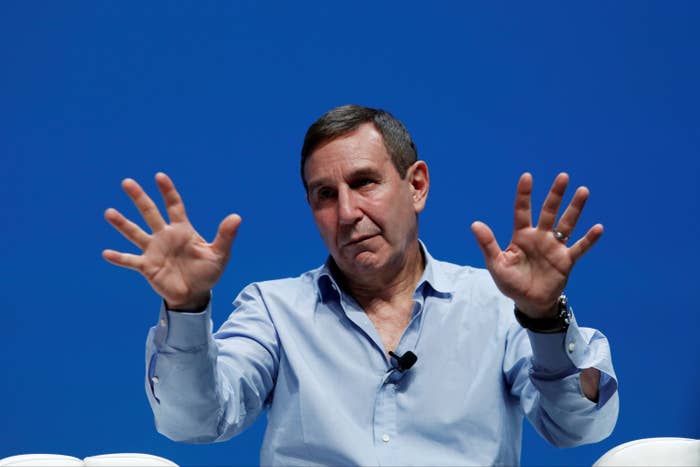Edelman, a PR firm that’s pledged to “work with an environmental conscience,” was paid $4 million to promote one of the most extreme fossil fuel trade groups in the country, new tax filings show.
Posted on March 12, 2021

BuzzFeed News; Getty Images
Edelman, one of the largest public relations firms in the world, has pledged never to work with climate deniers and proudly touts its work on environmental justice campaigns with brands like Tazo Tea.
But newly released tax filings obtained by Buz
"Edelman is basically misleading the public about its so-called green reputation,” Robert Brulle, an environmental sociologist at Brown University who studies climate lobbying and advertising, told BuzzFeed News.
The global public relations powerhouse has roughly 6,000 employees working to “promote and protect” prominent brands like Ikea, KFC, and Dove. Selling its own socially conscious image, the company has repeatedly stressed its commitment to efforts to “reduce emissions,” “work with an environmental conscience,” and “lead in the transition to sustainable and socially responsible business models.” On its website, Edelman proudly declares it worked with cleantech companies “long before climate change became a buzzword.”
But in recent years, Edelman has faced a backlash, both publicly and internally, over its willingness to take on high-profile campaigns for clients that are big polluters.
After four high-level executives quit in 2015 citing this issue, the firm publicly pledged never to work with coal clients or climate deniers. The vague commitment left the door open to a broad range of work for fossil fuel businesses or companies that have fought against regulations cutting carbon pollution.
“Right now the only categorical exclusion we have is on climate denial and coal,” Michael Stewart, then a top Edelman executive, told the Guardian in 2015. “When you are trying in some way to obfuscate the truth or use misinformation and half-truths that is what we would consider getting into the work of greenwashing, and that is something we would never propose or work we would support our client doing.”
But AFPM, a trade group that pulled in more than $55 million in revenue in 2019 alone, has aggressively opposed climate action and provided funding to the Heartland Institute, a climate denial group. AFPM has paid Edelman at least $12 million for public relations work from 2017 to 2019, tax filings show.
AFPM has taken some of the most extreme positions among fossil fuel trade groups, including helping create Energy4Us, a group that ran Facebook ads supporting the Trump administration’s rollbacks of national fuel efficiency standards without initially disclosing its ties to the oil and gas industry. The trade group also helped fund a campaign opposing a carbon tax in Washington state.
The trade group’s hardline climate policies prompted Royal Dutch Shell to announce in the spring of 2019 that it would not be renewing its AFPM membership, followed by the French oil company Total and the UK giant BP. All three oil companies, which are among the world’s top climate polluters, cited the trade group’s opposition to a carbon tax and lack of support for the Paris climate agreement in their decisions to quit.
AFPM is “not technically denying climate change but they might as well be,” said Andrew Logan, senior director of the oil and gas industry program at the corporate sustainability group Ceres.
“The only way to understand their policy positioning,” Logan added, “is that they will support any policy that encourages more use of oil products and they will oppose any policy that would lead to less consumption of oil products.”
Edelman did not respond to multiple requests for comment about what PR work it did for AFPM or if the group is still one of its clients.
AFPM also did not respond to a list of detailed questions from BuzzFeed News. But in a statement, it said, “We advocate for public policies that enable our members to safely and sustainably provide the fuels and petrochemicals that the world’s growing populations and economies need to thrive.” The trade association added, “We unequivocally acknowledge that climate change is real and that we have a role to play in reducing global GHG emissions.”

Eric Gaillard / Reuters
Richard Edelman, president and CEO of the public relations company
The fossil fuel industry is a huge potential source of revenue for public relations firms. Research by the Brown sociologist Brulle found that five big oil companies combined have “spent nearly $3.6 billion in advertising purposes for corporation promotion” from 1986 to 2015.
In addition to Edelman, AFPM paid another public relations firm, Singer Associates, roughly $14.5 million from 2017 to 2019. Singer Associates, based in San Francisco, has worked closely with Chevron on an “aggressive” crisis campaign after it was accused of environmental damage in Ecuador. Singer Associates also led a public relations campaign aimed at improving perception of Chevron's Bay Area refinery, where a 2012 fire led roughly 15,000 local residents in a low-income community to seek medical treatment.
Singer Associates “is honored to work for AFPM and Chevron,” Sam Singer, the firm’s president, told BuzzFeed News in an email, adding: “Our agency supports the Paris Agreement and is committed to helping to address climate change. Our work for AFPM and Chevron reflects our philosophy and beliefs.”
“As a policy, we do not discuss the details of work we perform for our clients,” Singer continued. “With that said, we did not work on Energy4Us.”
Edelman also did not respond to questions about whether it was involved in the Energy4Us campaign.
Edelman recently became a target of a public pressure campaign dubbed “Clean Creatives,” which is trying to get public relations firms and ad agencies to commit to refusing future contracts with fossil fuel companies, trade associations, and front groups.
And sometime over the past year, the firm quietly changed the section of its website dedicated to its “Position on Climate” to a position on “Energy and the Environment.”
Edelman did not respond to multiple requests for comment about what PR work it did for AFPM or if the group is still one of its clients.
AFPM also did not respond to a list of detailed questions from BuzzFeed News. But in a statement, it said, “We advocate for public policies that enable our members to safely and sustainably provide the fuels and petrochemicals that the world’s growing populations and economies need to thrive.” The trade association added, “We unequivocally acknowledge that climate change is real and that we have a role to play in reducing global GHG emissions.”

Eric Gaillard / Reuters
Richard Edelman, president and CEO of the public relations company
The fossil fuel industry is a huge potential source of revenue for public relations firms. Research by the Brown sociologist Brulle found that five big oil companies combined have “spent nearly $3.6 billion in advertising purposes for corporation promotion” from 1986 to 2015.
In addition to Edelman, AFPM paid another public relations firm, Singer Associates, roughly $14.5 million from 2017 to 2019. Singer Associates, based in San Francisco, has worked closely with Chevron on an “aggressive” crisis campaign after it was accused of environmental damage in Ecuador. Singer Associates also led a public relations campaign aimed at improving perception of Chevron's Bay Area refinery, where a 2012 fire led roughly 15,000 local residents in a low-income community to seek medical treatment.
Singer Associates “is honored to work for AFPM and Chevron,” Sam Singer, the firm’s president, told BuzzFeed News in an email, adding: “Our agency supports the Paris Agreement and is committed to helping to address climate change. Our work for AFPM and Chevron reflects our philosophy and beliefs.”
“As a policy, we do not discuss the details of work we perform for our clients,” Singer continued. “With that said, we did not work on Energy4Us.”
Edelman also did not respond to questions about whether it was involved in the Energy4Us campaign.
Edelman recently became a target of a public pressure campaign dubbed “Clean Creatives,” which is trying to get public relations firms and ad agencies to commit to refusing future contracts with fossil fuel companies, trade associations, and front groups.
And sometime over the past year, the firm quietly changed the section of its website dedicated to its “Position on Climate” to a position on “Energy and the Environment.”
In recent blog posts, CEO Richard Edelman has heralded the business community for being “prepared to take the lead in fighting the twin evils of climate change and inequality” and urged companies to consider setting climate science–based targets.












 Members of the Retail, Wholesale and Department Store Union distributed literature outside the Alabama warehouse where Amazon workers are voting on whether to join the union.Credit...Bob Miller for The New York Times
Members of the Retail, Wholesale and Department Store Union distributed literature outside the Alabama warehouse where Amazon workers are voting on whether to join the union.Credit...Bob Miller for The New York Times
 Amazon’s “inSTALLments” program used postings in warehouse bathrooms to communicate with workers.Credit...The New York Times
Amazon’s “inSTALLments” program used postings in warehouse bathrooms to communicate with workers.Credit...The New York Times







